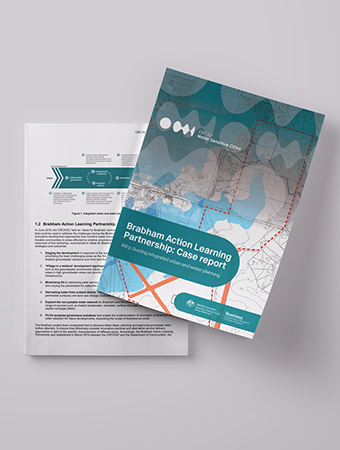Brabham opportunities revealed in new reports
Perth aspires to become an innovative 21st century city that’s liveable, prosperous, sustainable, collaborative and connected, and is planning to accommodate an extra 1.5 million people by 2050. Realising this aspiration will require approaches to urban planning that recognise the interlinks between water and urban systems. Developing an integrated planning approach that strengthens these links is the key focus of the CRCWSC’s Integrated Research Project 3 (IRP3).
As such, our IRP3 team has been actively involved in the Brabham development, a partnership between the Department of Communities and Peet Brabham Pty Ltd for a major residential subdivision in the City of Swan.
The CRCWSC is working closely with Brabham stakeholders
The CRCWSC's involvement with the Brabham development began in 2017 with a co-hosted research synthesis workshop to develop innovative water management and urban design approaches that could address the shallow groundwater challenges facing the Brabham project. Next, we joined the Brabham Action Learning Partnership with the Department of Communities, the Department of Water and Environmental Regulation (DWER), and Peet Brabham Pty Ltd, to explore how to implement the six ideas for innovative integrated water solutions for Brabham, as well as more broadly across the north-east growth corridor.
A key innovation at Brabham is the proposed use of subsoil drainage water to irrigate public open space. Other innovative approaches include adapting the urban and built form to shallow groundwater conditions, optimising wastewater servicing, and delivering amenity and enhanced environmental values through green and blue infrastructure. Our Integrated Research Project 5 team is currently developing best practice guidance for urban water management in areas that experience high seasonal groundwater.
Through the Brabham Action Learning Partnership, our research concluded the Western Australian planning system arguably leads the nation in its integration of water outcomes across all planning levels. But, like many other systems, how it looks on paper can be different to how it operates in practice.
While water outcomes are heavily embedded in the WA planning framework and in each level of land use planning, there are some challenges and opportunities around implementation.
We’ve now identified opportunities for greater integration
Working with practitioners over a nine-month period, we explored some of these implementation challenges for water sensitive urban development in shallow groundwater environments and came up with 11 planning and governance opportunities for improving aspects of integration. These are detailed in the recently released report, Enabling water sensitive urban development: planning and governance opportunities for Perth.
Some key insights from this work are widely applicable to urban and water planning across Australia. Notably, well defined processes for water planning at the corridor and precinct scale may still fail to realise opportunities for innovation.
In Western Australia, this was evidenced by a tendency to defer key water servicing decisions to subsequent stages of urban planning when spatial scales and timeframes limit the ability to consider solutions beyond business as usual. There’s also a lack of mandated controls for delivering integrated water management outcomes. An integrated approach to corridor or network scale of planning tends to be the missing link in water and urban planning across Australia.
The CRCWSC has also just released the Brabham Action Learning Partnership: Case report which documents the outcomes of the first two stages of the Brabham Action Learning Partnership. This report also summarises the technical and process constraints to innovation for Brabham, outlines the short-term and long-term implementation pathways for the proposed subsoil drainage water solution, and shares lessons for setting up and maintaining multi-stakeholder collaborations.
IRP3 project leader Chris Chesterfield said: ‘Getting people together to collaborate was really important for generating shared understandings, developing new or stronger relationships between collaborators, and building momentum for innovative on-ground outcomes.'
The IRP3 project is using the learnings from case studies such as Brabham to develop a framework and guidelines for ‘Integrated Urban and Water Planning’. It will be designed to help practitioners diagnose the governance and planning barriers to achieving water sensitive urban development unique to their city and to find ways to go beyond business as usual outcomes.
Time for action is now
The Waterwise Perth Action Plan and the planning reforms program currently underway in Western Australia provide a unique window of opportunity to strengthen integrated urban and water planning processes within state land use and water planning systems. The Water Sensitive Transition Network provides a key forum for exploring these opportunities and advocating for change as part of its efforts in creating more sustainable and liveable Perth communities.
Watch this space.
If you’d like more information on the Brabham project, contact our IRP3 Project manager, Sylvia Tawfik at sylvia.tawfik@monash.edu.
